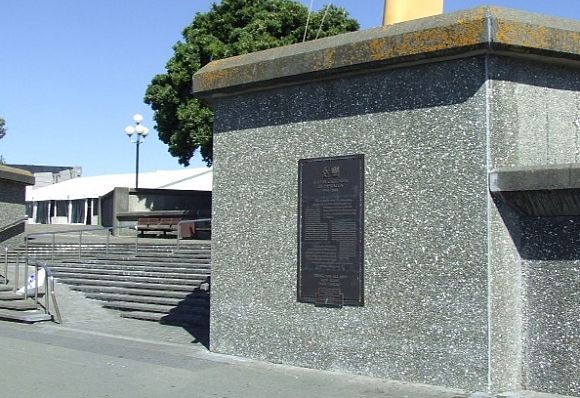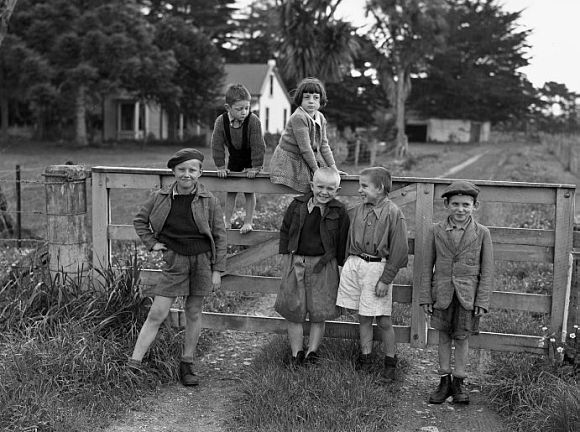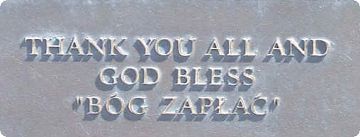Zeitblick
- Series A HillAc Production |
|
City,
My City - Series Two Part 3 The
Polish Children of Pahiatua
|
|
October 31st, 1944 was a clear and sunny day in Wellington as the USS General Randall nosed its way into the harbour. On board were Kiwi soldiers returning from active service in the East and US troops passing through on their way home. Also on board the General Randall were 732 Polish child refugees who had escaped war-torn Europe and the misery they had suffered there. In many cases siblings and parents had died or become separated as a result of the hardships they had undergone and it was New Zealand's privilege at that time to offer these children a place of security and safety. Aged from youngsters of 3 and 4 years old up to young men and women in their early teens, most were without parents and families, while some were lucky to have arrived with a brother or sister. As they sailed into the harbour the children stared in awe at the brightly painted houses and the lush green vegetation on the hillsides. This story commemorates the bravery and spirit of those children.
On September 1st 1939 the German Wehrmacht marched into Poland from the West while on the 17th of that month the armed forces of Russia, without declaration of war, invaded Poland from the East. The Polish Army was strong, and the Polish soldiers brave, but they were quickly overwhelmed by the mechanised German Blitzkrieg and, as such, were unable to seriously meet any Russian advance. Nazi Germany and the USSR divided Poland up between them and set about subjugating its people. It was the intention of Germany to utilise the Poles as slave labour for its industries, as the Russians embarked on a process of "russification" - a forerunner of the modern "ethnic cleansing". Germany pursued its policy of "lebensraum" - the creation of living space for its population - while Russia sought to destroy all and any opposition by deporting the Polish population to the vast snow-covered territories of northern and eastern USSR. To this end Stalin ordered the transportation of hundreds of thousands of Polish citizens to forced labour camps (gulags) in remote and inhospitable areas of Northern Russia, Siberia and the eastern provinces. To achieve this, Russia commenced a psychological war against the Poles designed to suppress and eliminate dissension wherever it occurred. The deportation of Polish families was undertaken in a manner designed to catch them completely unawares and soldiers would burst into the house in the middle of the night to ensure they caught the whole family in a physically low state of alertness. Stunned and half asleep the families were ordered to pack as quickly as possible for they were told that they were being transferred to another territory where all things would be provided. Households were searched for arms, and often looted of valuables by the Soviet soldiers, while the citizens were herded into railway cattle-wagons. This was a journey many were destined not to survive, succumbing to cold, starvation and barbaric treatment. Long years of suffering took its toll on thousands of families and by the middle of 1941 an estimated 1.5 to 2 million Poles had been deported. Many more Polish citizens would have perished (as was Stalin's design) had not the tables been turned on Russia and its armies. On June 22nd, 1941 Germany launched an all-out attack on the USSR, an attack which took the Soviet armies completely by surprise. As a result the USSR found itself fighting a common enemy alongside England and Poland who were its former enemies. It was time to cover up past deeds and mass murders, clandestine burials and forced marches to the east were a bid by the Russian Secret Police to conceal their abominable actions of recent years. In late July, 1941, England engineered the restoration of diplomatic relations between Russia and the Polish Government-in-Exile and a general amnesty was proclaimed for Poles in Russian labour camps and prisons. Suddenly tens of thousands of Poles found that they could return home, but there wasn't a home to return to. Beloved Polska was now a satellite state of communist Russia and much of its former lands were in Ukrainian hands. Under the amnesty the Polish Army was reformed, and its troops were needed by its allies in the Middle East. As a result 77,000 Polish soldiers and 43,000 civilians - 20,000 of whom were children - were shipped to Iran. From here the soldiers went to fight in North Africa and Italy leaving the civilians under the temporary protection of Iran. Appeals from the Polish Government-in-Exile resulted in the children with their adult minders being sent on to various countries within the League of Nations, the former United Nations. New Zealand responded to this plea and wartime Prime Minister, Peter Fraser, invited a group of 732 children and 102 guardians to New Zealand. The journey to Pahiatua had begun. By train and by ship the children were transported south, boarding one cramped, damp and disreputable cargo ship after another. At Bombay, in India, the children thought they had stepped into paradise when they boarded the American transport USS General Randall. The damp mattresses and unhygienic conditions were replaced with canvas bunks, wash basins, showers with plenty of hot water and excellent food and, for the first time in a number of years, the children experienced kindness and compassion at the hands of the soldiers on board.
Upon their arrival in Wellington the children were greeted by the welcoming whistle of the Polish ship Narwik, coincidentally in port on this day. The children were taken to Wellington Railway Station where they boarded a train to Pahiatua. Hundreds of Wellington children bid farewell to them on their journey waving Polish flags and all along the route, as a gesture of goodwill, groups of New Zealand children cheered the new arrivals. Over thirty army trucks transported the children from Pahiatua station to the camp whose official name was now "Polish Children's Camp in Pahiatua". Beds were made up with fresh, clean sheets, vases of flowers were put on tables and the camp was made tidy, ready for their arrival. A former camp for "alien internees", the camp at Pahiatua, situated near the Pahiatua Racecourse, was completely re-modelled to become a secure shelter for these children who had been through so much. The old watchtowers worried some of the children as it was something they were used to in Russian camps but for all the wrong reasons. The watchtowers were soon removed.
The Polish children in Pahiatua enjoyed an almost idyllic lifestyle in comparison with what they had recently endured. When not attending to their studies, hikes into the nearby bush and countryside and trips to the local river were favourites. Many made friends with New Zealand children and were invited to spend time with New Zealand families where they came face-to-face with a new language, new customs and new experiences. None, however, failed to make their mark. The Polish children readily adopted the New Zealand way of life while New Zealanders expressed their fondness for these child refugees from war-torn Poland. From these relationships, many long lasting friendships were formed. It had been intended that after the war the children would return to Poland, however, with the political changes taking place in their former homeland, few wanted to and it was at this time that the New Zealand Government gave them assurances that they could remain in New Zealand as long as they wished. Even the Russian-installed government in Warsaw had the temerity to send an envoy to New Zealand to check on conditions in the children's camp and had no option but to return to Poland completely satisfied. Many of the Polish children decided to remain in the country that had given them succour and friendship and many went on to marry New Zealanders or other Poles. Whilst never losing their love for their former homeland, these new residents of New Zealand became highly regarded and, in many cases, respected and distinguished citizens.
© Peter Wells, Wellington, New Zealand |




